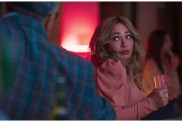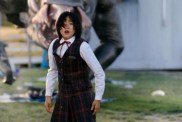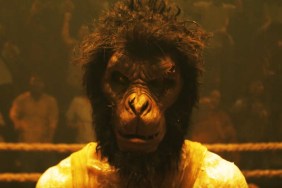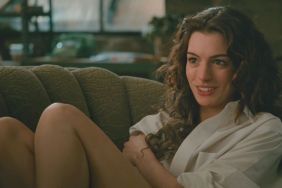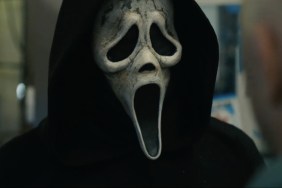
Walt Disney Pictures and Lucasfilm just released Rogue One: A Star Wars Story on Blu-ray Combo Pack, DVD and On Demand. To coincide with the release, ComingSoon.net had an exclusive 1-on-1 chat with Doug Chiang, the Rogue One production designer who also developed the visual look of The Phantom Menace and Attack of the Clones, as well as the more recent Star Wars: The Force Awakens!
Click here to order Rogue One: A Star Wars Story on Blu-ray!
ComingSoon.net: So I guess this is signaling the end of a pretty long process for you, because I know you were involved in “Force Awakens” and then went right into this. So how have the last four or five years been treating you?
Doug Chiang: (Laughs) No, it’s actually been really thrilling. I’m just so happy to be back in the “Star Wars” universe. I started working with George on the prequels, I didn’t think there would ever be another opportunity to design for “Star Wars.” I have to say, working on “Rogue One” was sort of the combination of everything in terms of when I first saw “Episode IV” when I was 15, because I’ve always wanted to do design that would fit into “Episode IV.” And so, “Rogue One” gave me that opportunity. I’m thrilled with that.
CS: Now this was interesting because I know in the prequels, you actually had a little bit of leeway, in the sense that you were so far before the original trilogy that you could kind of come up with some different looks. It was more of an art deco kind of throwback look. But on this one, it’s so close to “A New Hope.” How did you try to keep it contemporary, but also make sure to adhere to that design aesthetic?
Chiang: That is a really good question because that’s the question we asked ourselves. We knew “Rogue One” was going to take place right before “Episode IV.” So a majority of our design had to fit seamlessly with “Episode IV.” Their approach was finding what percent had to fit. There are fewer designs in the sense that you won’t just build the thing. So for instance, the Yavin hangar. We saw bits of it in “Episode IV,” but what if George had turned the camera around the other way?

What it allowed us was to design something that was heavily influenced by “Episode IV” and stayed true to it, but yet it gave us license to open up and expand the design vocabulary a little bit more, while still fitting in. It was a really great approach for us, because we knew that the design had to feel as if we were designing a movie, as if we were designing an alternate version of “Episode IV.” But then, we also knew because of the film before, there was going to be a small percentage, maybe 20 percent of new designs, and that was going to give us the excuse to bridge “Episode III” to “IV,” to have that design history lineage, to make sense of all that.
That’s one of the great things. When I started working on “Star Wars” George said, “You know, we’re going to try something new,” that we weren’t going to copy old designs. It seems like that was the best thing because the process of designing for “Star Wars” was exactly the same. The only difference was the result, but I got to understand how George approached designs for “Star Wars.” He created our design history so that there are a lot of visual distinctions. Like, “IV,” “V” and “VI” can be easily anchored in the ’50s, ’60s and ’70s designs, and “I,” “II” and “III” are in the ’20s and ’30s. When you know that you can then fill in the gaps, you know how to bridge the non-aesthetics.
And so, for “Rogue One” it was filling in that 20 percent of new that could help build out the universe. The designs that we were creating had to have a reason for existing, because in some ways, a lot of the designs don’t exist after “Episode IV.” We had to figure out, “Well, if we create something that was too fantastic, why did it not work?” We knew that they had to fit within that timeline, and we also knew we never saw it after “Rogue One.”
The thinking was that maybe this was an earlier version from a manufacturer of the X-Wing. If we’re thinking about “IV,” “V” and “VI” classic design and sort of functional practical designs, flying design, the prequels were more romantic, more handcrafted. The E-Wing kind of had a little bit of that. There were elements that were manufactured, but they were elements that were perhaps handcrafted. It really was obsolete technologies so that it gave us the excuse to bridge that. Storyline wise, universe wise, there was a reason why.

CS: Right. I love the beautiful art books that they came out with for “The Force Awakens” and for this movie. What was a design that you were particularly fond of that didn’t make it through the final approval process?
Chiang: For “Rogue One”? (Laughs) There were actually quite a few. A lot of it was driven by story needs and also aesthetics. Part of the design challenge was we had to push the envelope, explore that gray area of what is “Star Wars,” and sometimes we would go too far and then we’d kind of reign ourselves in. And sometimes, we’ll come up with very interesting designs, that perhaps don’t quite fit or are too extravagant. There were early versions of the space dock, for instance, or Scarif, but it didn’t quite make sense for the story, that it was almost too much technology. We found ourselves struggling with trying to come up with why is this here and what is its purpose? Let’s kind of strip away and see what is the logic of its single purpose?
So there’s things like that. Other things we were exploring, like Dantooine Base. That was in the early version of the outline. Unfortunately, we didn’t see it in the final version, but we actually did quite a detailed design really figuring out what it could be. A lot of it was kind of feeding off of the inspiration of Ralph McQuarrie way back. When George works on these films, he likes to have the designers explore a whole bunch of different ideas and then pick the one or two that would end up in the movie.
But there’s a whole wealth of designs that never made it into the movies. One of the first things that we did for “Rogue One,” I took Gareth up to the Lucas Archives. We went through essentially all those rough Ralph McQuarrie early designs. There were some really wonderful designs. In particular, there’s one painting that we all gravitated towards, which was an early version of Dantoonie with this grassland and a giant termite mound. It was not just a striking image, but we felt compelled that, “Okay, if we’re going to do this, let’s start there and then see how it evolves.”

CS: “Force Awakens” kind of steered away from a lot of the stuff from the prequels, but “Rogue One” actually did incorporate some elements like Coruscant and Mustafar some of those other things. I know fans are actually very high on the idea of seeing more of the prequels integrated within the new movies, to be acknowledged. Do you think that we’ll be seeing more from those earlier eras in the “Star Wars” universe in the new films?
Chiang: Yeah, I would hope so. They are a part of the design history of “Star Wars” and we felt very strongly that for “Rogue One,” there should be that bridge. When you reflect on the whole design of “Star Wars,” it actually makes the designs for the specific film even more authentic, and in a really grounded reality, so you’re kind of designing with a long history of design. That’s what I love about “Star Wars” design, is that it is grounded in history.
There is an actual foundation that underlines everything you’re seeing. The audience may never realize that or appreciate that, but it’s all there and it’s part of the homework that we do, because I think it’s very important and is a key component to creating designs that are timeless. When you look at “Episode IV,” it’s totally in there, in terms of the design history, how things fit, why they’ve evolved, why it makes sense. It creates this very immersive world, where there are a lot of questions and you don’t ask those questions because the world seems like it makes sense. George always describes “Star Wars” as like a foreign film, that when you look at a foreign film, there’s so many exotic things in the background, but yet they’re all just background material. If you go into it, every piece fits, and that’s what we’re doing for “Star Wars” is we do months of homework in terms of figuring out the world itself. Ultimately, when it’s presented in the cinema, very little of it is explained, but there is an inherent perfect feeling that you get that it all makes sense because it really does.
CS: After “Rogue One” I’m not sure if you’re still involved in the “Star Wars” universe at Lucasfilm. Is there more “Star Wars” in your future?
Chiang: Yes. My role here is, I oversee all the designs for all of the “Star Wars” film franchise, including theme parks, games and films. So I’m very lucky.
CS: Do you think we’ll be able to see some of your work in “Episode VIII”?
Chiang: I hope so. I can’t comment directly.
